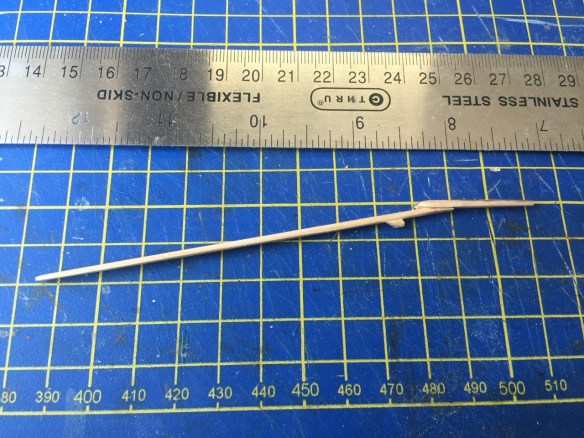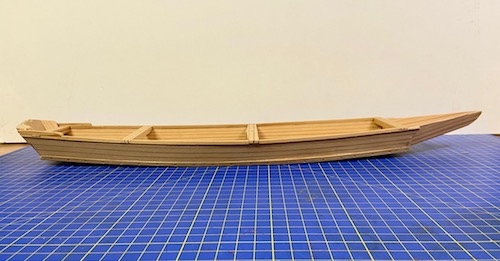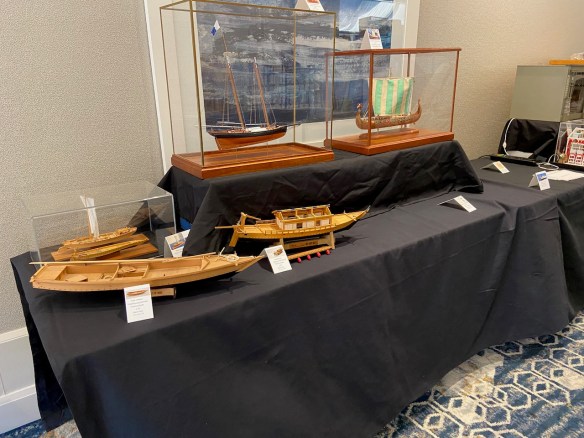




It’s been developing slowly over the years, but The Rope Tokyo, has been updating their website with an increasing amount of material on traditional Japanese ships and boats and their models. Over the years, they’ve added some material from presentations given at their regular meetings. But, more recently, they’ve added a section showing types of ships and boats, based on model built by members, as well as a section showing models of boats preserved at the Ota ward local museum (a collection that I was actually involved in discovering).
If you’re visiting this site now, there’s a good chance that you seen the new FX series Shōgun, based on the novel by James Clavell. You’ve then also seen some of the watercraft that appears and may be wondering how accurately they are depicted. I’ve only seen the first couple episodes, and I haven’t had a chance to study them too closely yet. And, honestly, I was too engrossed in the story line, characters, and imagery to spend a lot of time studying the accuracy of the boats too closely yet. But, at first glance, things looked very good.
By the way, I got the above image from FX’s Shōgun Viewers Guide, which you can link to here. Continue reading
I just discovered that an acquaintance, Mr. Tomohiko Ogawa, a boatbuilder and artist in Japan, has set up a new wasen website about Traditional Japanese Wooden Boats. The site is primarily in Japanese, but does include some english language text to accompany most of the titles. You can find it here: https://traditionalwoodenboat.jpn.org/
This is mostly an overview of his own works, but he has done quite a bit. You may recall that he provided the information for me to model the Hasumibune, Ogura Pond boat.
 He’s currently working on a full-sized version of this boat. Sadly, I don’t believe there any living boatbuilders that can clear up some of the questions about the construction of this boat type. After building this model, I have some thoughts as to how the full-sized boats were built, but I haven’t talked to him about it lately. However, he did mention my work on his website: https://traditionalwoodenboat.jpn.org/n-20220801/
He’s currently working on a full-sized version of this boat. Sadly, I don’t believe there any living boatbuilders that can clear up some of the questions about the construction of this boat type. After building this model, I have some thoughts as to how the full-sized boats were built, but I haven’t talked to him about it lately. However, he did mention my work on his website: https://traditionalwoodenboat.jpn.org/n-20220801/
You can also follow Ogawa-san’s work on Instagram here. Ω
I was recently alerted by Glenn Schuster that there is currently an Ebay auction for an old Woody Joe kit from the days before laser cutting, where all parts were still made from milled wood. The kit is a Edo period Japanese coastal transport similar to their current Higaki kaisen and Kitamaebune offerings and goes by the common name for these ships, Sengokubune or 千石船, as it is written in Japanese.
 The kit is made in 1/60 scale, so the model is slightly larger than the current 1/72 scale offerings at about 22.4″ long and 19.7″ high. I know there’s a sign on it that says it’s 1/30 scale, but I confirmed long ago with Woody Joe that this is an error and it’s actually 1/60.
The kit is made in 1/60 scale, so the model is slightly larger than the current 1/72 scale offerings at about 22.4″ long and 19.7″ high. I know there’s a sign on it that says it’s 1/30 scale, but I confirmed long ago with Woody Joe that this is an error and it’s actually 1/60.
Bidding starts at $120 plus shipping, and I’m hoping someone out there will bid on this kit. If not, I may end up bidding on it, and I don’t really need to be spending money on this kit, as I already have one. I’ve been hesitant to build the kit I have, as once I start building it, there will be no more Sengokubune kits available.
The model is not as detailed or as accurate as the current Woody Joe kits, but it’s big and makes a nice display model. Plus, it can be detailed up a bit if desired.
If you’re interested, bidding ends on Saturday, 5/6/23 at 6:10pm. As of today, 5/1/23, there have been no bids placed on it. You can find the item on Ebay here: https://www.ebay.com/itm/125910896848
If you win the bidding on this, let me know. Maybe I’ll be encourage to pull mine out of storage and we’ll build them together and share notes. Ω
I moved ahead with the small nitaribune model, a 1/20-scale model of a cargo boat based on drawings by the late Mr. Seichi Fujiwara, who was one of Douglas Brooks’ teachers in Japan.
The boat is about the right length, but somewhat narrow for a traditional nitaribune. This one would be about 5′ wide in real life. But, according to the Funakagami, these boats were about a foot wider and possibly a little shorter, making the actual boats a little less sleek looking as this. I tend to attribute the sleek lines to represent more of a modern evolution of the traditional Japanese boat.
Last weekend, I had a number of models on display at the Good Sam Showcase of Miniatures, which consisted mostly of my wasen models. This was the first time I’d had any of my Japanese watercraft models on display since January, and it seems to have spurred me to get back to work on some wasen model projects. While I have the two Woody Joe kits to finish up, those being the Kitamaebune and Atakebune kits, I also have two scratch models I stated long ago, the whaleboat-style Senzanmaru, and the small Nitaribune based on the late Fujiwara-san’s boat Kawasemi.
I finally managed to get some of my wasen models out on display, if only for a couple days. The models are included in a group of ship and boat models at the Good Sam Showcase of Miniatures this weekend.
This weekend is the annual Good Sam Showcase of Miniatures, an event organized primarily for doll house enthusiasts. But, as the overall theme is “miniatures”, the organizers were happy to include ship models and boat models. The event takes place at the DoubleTree Hotel in San Jose on Saturday and Sunday, October 8th and 9th. Those interested should visit their website at https://goodsamshowcase.org. This year, the South Bay Model Shipwrights club is participating, and I brought some models for display.

For this exhibit, I brought my Mary Taylor model, a 1/72 scale Japanese boats display, a 1/10 scale Japanese fishing boat, and a 1/24 scale Japanese pleasure boat. I also brought in the South Bay Model Shipwrights club’s Drakkar Viking Ship, which was a group build. I didn’t participate in its construction, but the model was on display at Ages of Sail, and I made arrangements to pick it…
View original post 338 more words
Apologies to any followers who discovered they couldn’t get to my website here. Minor issues with the domain hosting that I didn’t notice, following a billing change that just happened to coincide with the renewal of the wasenmodeler.com domain name. Everything was taken care of last week, but I hadn’t noticed that all domain name services got reset in the process. In fact, I didn’t even know there was an issue until it was pointed out to me this morning.
 But, all is well now. No major issues, and we’re good for at least another year!
But, all is well now. No major issues, and we’re good for at least another year!
I’m playing a little “catch up” on my blog regarding the Oguraike boat. As a reminder, this is a boat used for fishing and sightseeing in Kyōto, which was the former capital of Japan, prior to the Edo period. The boats were used until the pond was drained in the 1930s as part of a reclaimation project. My model is a 1/10-scale reproduction, based on the research of Mr. Tomohiko Ogawa, an artist and boatbuilder living in Kyōto.
 Again, I don’t know the term for the bottom connecting plank, but with it now in place, I went ahead and added these mortises. On the actual boat, nails are driven into the side, to fasten the plank to the shiki, or bottom board. Nails are also driven up through the bottom edge, to fasten the plank to the hull plank. On the real boat, it would make more sense for this to be nailed first to the hull plank, then that whole plank assembly nailed to the bottom board.
Again, I don’t know the term for the bottom connecting plank, but with it now in place, I went ahead and added these mortises. On the actual boat, nails are driven into the side, to fasten the plank to the shiki, or bottom board. Nails are also driven up through the bottom edge, to fasten the plank to the hull plank. On the real boat, it would make more sense for this to be nailed first to the hull plank, then that whole plank assembly nailed to the bottom board.